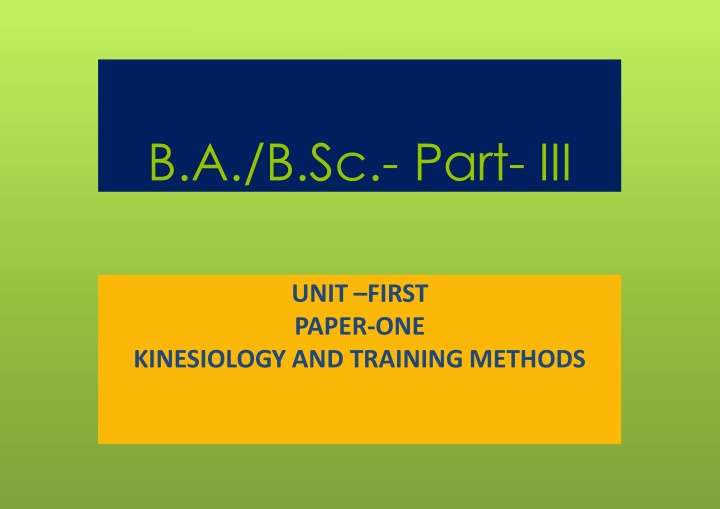
Exploring Kinesiology: Definition, Types, and Applications
Discover the meaning and sources of kinesiology, its various types like structural and clinical kinesiology, and the connection with biomechanics. Explore how kinesiology delves into human body movement and its scientific analysis, combining mechanics, anatomy, and physiology for a comprehensive study.
Download Presentation

Please find below an Image/Link to download the presentation.
The content on the website is provided AS IS for your information and personal use only. It may not be sold, licensed, or shared on other websites without obtaining consent from the author. If you encounter any issues during the download, it is possible that the publisher has removed the file from their server.
You are allowed to download the files provided on this website for personal or commercial use, subject to the condition that they are used lawfully. All files are the property of their respective owners.
The content on the website is provided AS IS for your information and personal use only. It may not be sold, licensed, or shared on other websites without obtaining consent from the author.
E N D
Presentation Transcript
B.A./B.Sc.- Part- III UNIT FIRST PAPER-ONE KINESIOLOGY AND TRAINING METHODS
MEANING , DEFINITION, SOURCE AND TYPES OF KINESIOLOGY
MEANING OF KINESIOLOGY The word kinesiology is taken by the combination of two greek words Kinesis meaning movement or motion and Logos meaning "to discourse or to study . Kinesiology means the science which speaks of movement or motion. Kinesiology is the science which investigates the human body movements or motion.
DEFINITION OF KINESIOLOGY It is a field of study based upon the anatomical and mechanical analysis of human motion . HAY & REID It is a scientific study that investigates and analyzes human motion . M. GLADYS SCOTT
KINESIOLOGY & BIOMECHANICS Kinesiology is the title traditionally given to a course concerning the anatomical and mechanical bases of human movement related specifically to sport, dance, and adaptive activities Biomechanics is defined as that area of study wherein the knowledge and methods of mechanics are applied to the structure and function of the living human system.
SOURCE OF KINESIOLOGY The basic foundation of kinesiology lies in three major areas of knowledge namely: Mechanics, Anatomy, & Physiology.
TYPES OF KINESIOLOGY For the purpose of teaching and coaching kinesiology can be classified into two major headings: 1-Structural kinesiology 2-Clinical kinesiology
STRUCTURAL KINESIOLOGY The Structural kinesiology is basically the study of muscles as they are involved in science of movement. More than 600 muscle are found in the human body but the large muscle that are primarily involved in movement of joint are focused for study in physical education and sports for students.
CLINICAL KINESIOLOGY Clinical kinesiology is the study to understand the force acting on the human body and to manipulate these forces so that human performance may be improved or injury may be prevented.
MECHANICS & ANTHROPOMETRICS The area of study concerned with the mechanical aspects of any system is called Mechanics and may be divided into two categories: statics, the study of factors associated with non-moving systems, and Dynamics, the study of factors associated with systems in motion. The area of study concerned with measures of the body s physical characteristics is Anthropometrics. PROFESSOR VIJAY CHAHAL D.D.U GORAKHPUR
References www.slideshare.net/shimaa2022/planes-axes www.slideshare/TodaysfitnessTrainerttf-planes-axesmovement Biomechanics: A qualitative approach for studying Human Movement, second edition. Ellen Krieghbaum, Katharine Barthels, Macmillan Publishers, London. Textbook of Kinesiology, V.D. Bindal, The Health Science Publisher, New Delhi I London I Panama
